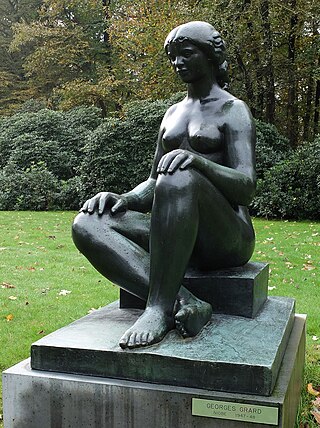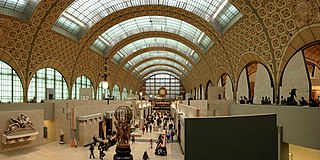
Aristide Joseph Bonaventure Maillol was a French sculptor, painter, and printmaker.

The Musée d'Orsay is a museum in Paris, France, on the Left Bank of the Seine. It is housed in the former Gare d'Orsay, a Beaux-Arts railway station built between 1898 and 1900. The museum holds mainly French art dating from 1848 to 1914, including paintings, sculptures, furniture, and photography. It houses the largest collection of Impressionist and post-Impressionist masterpieces in the world, by painters including Berthe Morisot, Claude Monet, Édouard Manet, Degas, Renoir, Cézanne, Seurat, Sisley, Gauguin, and van Gogh. Many of these works were held at the Galerie nationale du Jeu de Paume prior to the museum's opening in 1986. It is one of the largest art museums in Europe.

Antoine Bourdelle, born Émile Antoine Bordelles, was an influential and prolific French sculptor and teacher. He was a student of Auguste Rodin, a teacher of Giacometti and Henri Matisse, and an important figure in the Art Deco movement and the transition from the Beaux-Arts style to modern sculpture.

Alexandre Cabanel was a French painter. He painted historical, classical and religious subjects in the academic style. He was also well known as a portrait painter. According to Diccionario Enciclopedico Salvat, Cabanel is the best representative of L'art pompier, and was Napoleon III's preferred painter.

The Thinker is a bronze sculpture by Auguste Rodin, usually placed on a stone pedestal. The work depicts a nude male figure of heroic size sitting on a rock. He is seen leaning over, his right elbow placed on his left thigh, holding the weight of his chin on the back of his right hand. The pose is one of deep thought and contemplation, and the statue is often used as an image to represent philosophy.
Paul Jenkins was an American abstract expressionist painter.
Richard Guino was a French sculptor of Catalan origin.

Dina Vierny was an artists' model who became a singer, French art dealer, collector and museum director.

George Grard (1901–1984) was a Belgian sculptor, known mostly for his representations of the female, in the manner of Pierre Renoir and Aristide Maillol, modelled in clay or plaster, and cast in bronze.

Robert Couturier was a French sculptor. He was born in Angoulême.

The Musée Maillol is an art museum located in the 7th arrondissement at 59–61, rue de Grenelle, Paris, France.

Air is a lead or bronze sculpture, by Aristide Maillol.

La Rivière is a lead or bronze sculpture by Aristide Maillol.

Flora, Nude is a sculpture by French artist Aristide Maillol.

The Rudier Foundry was a foundry run by Alexis Rudier and his son Eugène Rudier (1875–1952). It worked with some of the most notable sculptors of the 19th and 20th centuries, including Auguste Rodin, Antoine Bourdelle, Gustave Miklos, Aristide Maillol and Daumier. Their casts were signed "Alexis RUDIER Fondeur PARIS".

Action in Chains is a 1905 bronze sculpture by Aristide Maillol. The original called Monument to Blanqui was commissioned by Louis Auguste Blanqui, and resides at the Puget-Théniers, for which it was originally commissioned.

The Musée Maillol de Banyuls-sur-Mer is a private museum at the farm of the sculptor Aristide Maillol where he spent the last years of his life. The farm, "La Métairie", is situated in the Roume valley 4 km from the city center of Banyuls-sur-Mer in the Pyrénées-Orientales. The museum is operated by the Fondation Dina Vierny, which also operates the Musée Maillol in Paris.

The 136 museums in the city of Paris display many historical, scientific, and archeological artifacts from around the world, covering diverse and unique topics including fashion, theater, sports, cosmetics, and the culinary arts.

Rhinocéros is a 1878 sculpture by Henri Alfred Jacquemart; a life-sized depiction of a rhinoceros in cast iron. Commissioned to stand outside the Trocadéro Palace for the 1878 Exposition Universelle, it was completed quickly to be ready in time for the opening of the fair. Well received at the time, it was moved in 1935 to allow for the remodelling of the palace and grounds for the 1937 Exposition Internationale des Arts et Techniques dans la Vie Moderne. The sculpture was sited near to the Porte de Saint-Cloud before being acquired by the Musée d'Orsay in 1985. It now stands in the esplanade in front of the museum, with two other animal statues from the 1878 exposition.

















